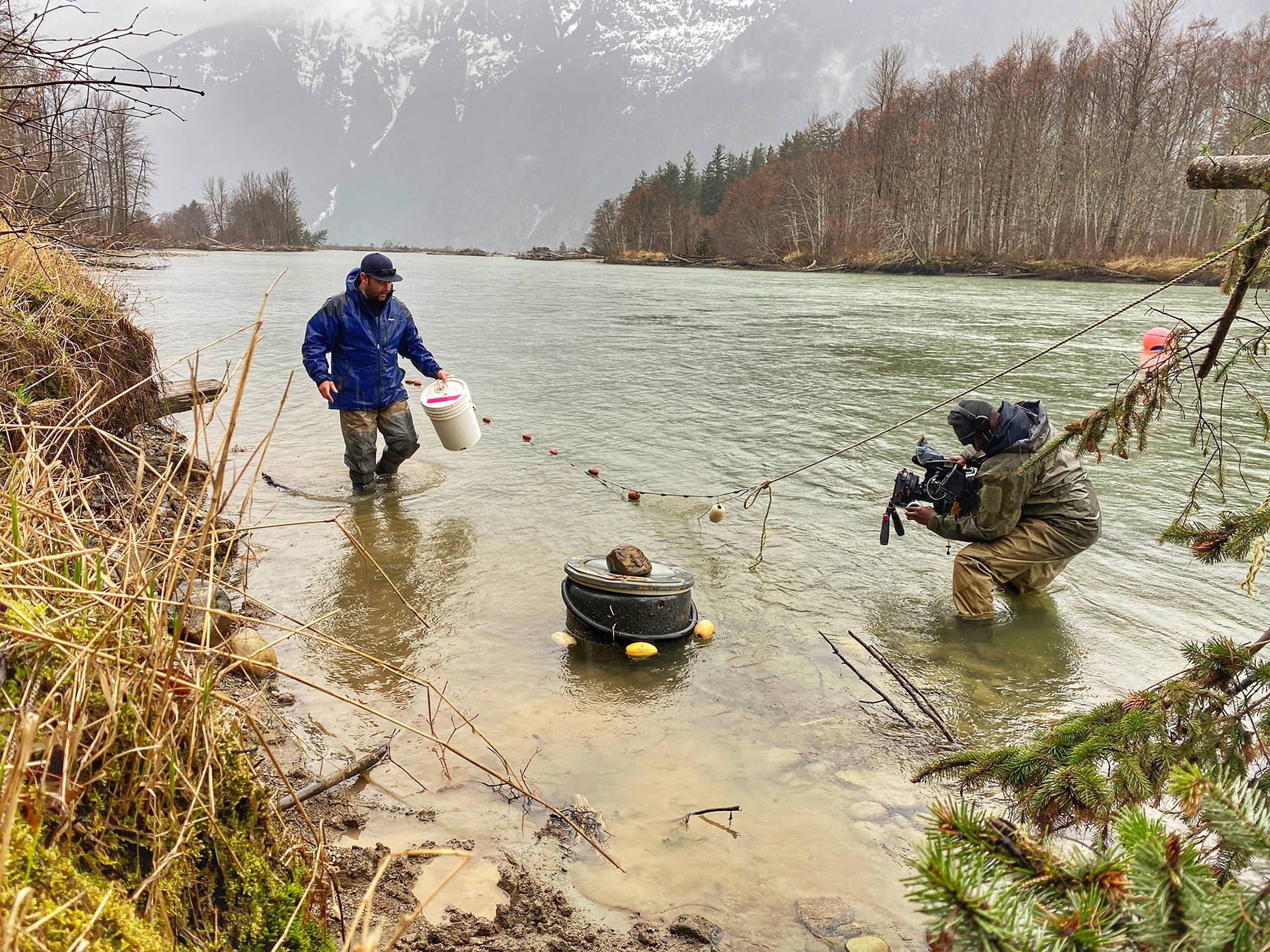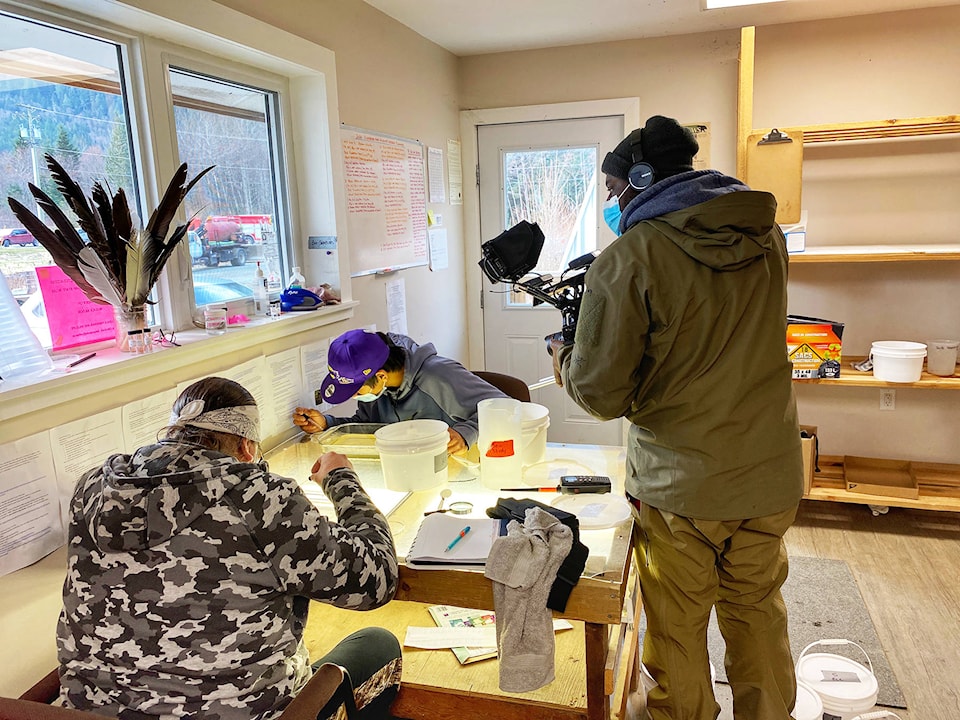It has been decades since the waters of the Bella Coola have been black with eulachon and the riverbanks buzzing with preparations, fishing and people. The eulachon was more than a food source for Nuxalk people; it was a species key to their survival. The return of the eulachon meant an end to the long months of winter hunger, and signalled that spring was about to begin.
The loss of this precious fish is more than just the loss of a food source. It’s the loss of a way of life, and in the eyes of Nuxalk filmmaker and director Banchi Hanuse, the return of sputc is dependent on the return to the way of life that supported it.
Weaving together live action, animation, archival images, ancestral stories and songs, the documentary Sputc: We Shall Eat When the River is Full is a cinematic tale of wealth, loss and recovery.
“It has to do with the way that Nuxalk people lived and treated things,” explained Hanuse. “They took care of others, the land and the waters, so people didn’t feed themselves until every other living being had a chance to eat. To me it represents the bigger picture of what’s going on within ourselves and our lives.”
Filming began six years ago when the sputc pole was raised in the first community ceremony in years, celebrating the time when eulachon would traditionally return. The ceremony has since been repeated every year since, along with the ongoing research conducted by Nuxalk scientist Megan Moody, who specializes in eulachon research.
The Bella Coola eulachon crashed dramatically in 1999, and Moody’s findings have pointed to several factors contributing to the decline in eulachon populations. She believes that climate change was already contributing to a slow decline in eulachon populations, something that had been happening since the 1970s.
However, it was the arrival of shrimp trawlers in Queen Charlotte Sound in the mid-90s that appears to have been a major contributor to the spectacular disappearance of 1999.
“Eulachon bycatch was a huge problem for the shrimp trawlers in Queen Charlotte Sound,” explained Moody in 2014. “There are estimates that between 90 and 150 tonnes of eulachon was being caught as bycatch by the trawling industry.”
Since that crash over 20 years ago the community has suffered in more ways than one. Eulachon represented an entire system of life unique to coastal peoples: weeks of fishing, preparation, and preservation happened year after year in a predictable and systematic fashion.
READ MORE: Bella Coola sees biggest run of eulachon in almost 20 years
Entire villages sprung up on riverbanks as community members came together in extended family groups to undertake the yearly ritual.
The grease gathered from all of that work was then consumed as food and medicine, supporting an entire trade economy that stretched from the coast to the Rocky Mountains.
Hanuse remains acutely aware of the complexity of telling this story, understanding that it’s not simply a tale of a lost resource.
“It’s not just about a fish,” she said. “It’s about a way of living we must return to if we want to survive, and everything within our territory depends on it.”
For the Nuxalk, eulachon are much more than a food source; they are a cultural treasure. For thousands of years they were the hub of trade activity on the Central Coast and a symbol of the richness of nature. Grease was essential to survival, health, and a source of traditional wealth. Their loss has been devastating.
Hanuse is perhaps best known for her 2010 documentary Cry Rock, which examines how Nuxalk stories are more than mere words. With the passing of an elder, an invaluable link to a treasure of knowledge and experience reflecting the Nuxalk world view is lost. Cry Rock went on to win nine awards.
The live action filming is being crafted by Haitian/Canadian cinematographer Louvens Remy. This is Remy’s third time filming in Bella Coola, as he also worked on the 2013 film, Bear Witness and the short film, Nuxalk Radio, which won the Vancouver International Film Festival Sea to Sky Award presented by Telus in 2020.
“Usually, filmmakers and crew come in, mine for information and leave without much interaction with the community. Louvens was different,” said Hanuse. “He was eager to spend time with us, even joining our softball team as we were short on players. It was not only his home runs leading us to victory that won us over, but his kindness and lack of ego.”
“Believe it or not the most enjoyable experience was getting up at 4 a.m. and filming the eulachon study with the Nuxalk Fisheries group,” Remy shared. “Like everyone else, the prospect of getting up at 4 a.m. is not appealing but once we got going and I got some fresh air into my lungs I became very switched on to my environment. I didn’t know quite what to expect as I gathered my camera and pulled on my hip waders in the dark.
“It was exhilarating because of the threat of not knowing where I was stepping as I tried not to fall in the cold, dark river while maintaining my balance to get the best shot I could. It was nice also knowing that I was witnessing the work of Nuxalk people in trying to preserve something unique to British Columbia.”
Remy said that the opportunity to film a story about eulachon and their significance to Nuxalk people left a lasting impression. That, and the weather, of course!
“I was impressed by the dedication of the fisheries group to never miss a day in their endeavor to collect samples and to better understand the eulachon. I was also impressed by the resiliency of the Nuxalk people. I really saw how much the loss of the eulachon affected them and how much that this little fish means to them as not only a source of food but medicine for the people,” said Remy. “I guess you could say I was impressed by the immense importance of something so small and the big effect it has on a community. Also, the weather. I’ve been to Bella Coola quite a few times but I’ve never seen the weather turn on its head every 15 minutes or so. It made for quite a challenging shoot at times.”
As Hanuse explains, the film is being developed for the Nuxalk community and will be premiered in Bella Coola before any decisions are made about where else it may go.
“The film is for the Nuxalk people first and foremost,” said Hanuse.
“It may be screened in other locations but that has yet to be determined.”
While no date has been set for the premiere Hanuse expects the project to wrap up within the year. For more information on Hanuse’s work you can visit her website at www.smayaykila.com.
editor@wltribune.com
Like us on Facebook and follow us on Twitter

